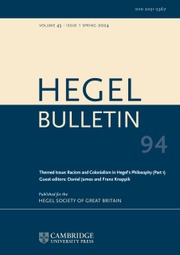No CrossRef data available.
Article contents
Toward a Formal Interpretation of Kant's Analogies of Experience
Published online by Cambridge University Press: 23 June 2015
Abstract
Very often, the rise of non-Euclidean geometry and Einstein's theory of relativity are seen as the decisive defeat of Kant's theoretical philosophy. Scientific progress seems to render Kant's philosophy obsolete. This view became dominant during the first decades of the twentieth century, when the movement of logical positivism arose. Despite extensive criticism of basic tenets of this movement later in the twentieth century, its view of Kant's philosophy is still common. Although it is not my intention to defend Kant infinitely, I think that this view is rather unsatisfactory and even misleading.
Let us consider the first factor: non-Euclidean geometry. If one reads the first Critique carefully, it becomes clear that the claims of transcendental logic do not imply Euclidean geometry. Kant's notion of space, as explained in the aesthetics chapter, is rather limited: it does neither entail nor presuppose a specific form of geometry (Cf. B37-B57). None of his statements about the form of space is specific enough to imply or support Euclidean geometry. Although Kant uses several examples, Euclidean geometry does not play any systematic role; only the pure form of space is at issue in the aesthetics chapter. In my view, the same holds in the case of Newton's physics: it is neither presupposed nor entailed by Kant's transcendental logic. The justification of Newton's physics requires further specialisation and application of the transcendental framework to empirical concepts like matter and motion. Kant took this step in his Metaphysical Foundations of Natural Science.
- Type
- Articles
- Information
- Bulletin of the Hegel Society of Great Britain , Volume 28 , Issue 1-2: number 55/56 , 2007 , pp. 107 - 120
- Copyright
- Copyright © The Hegel Society of Great Britain 2007




